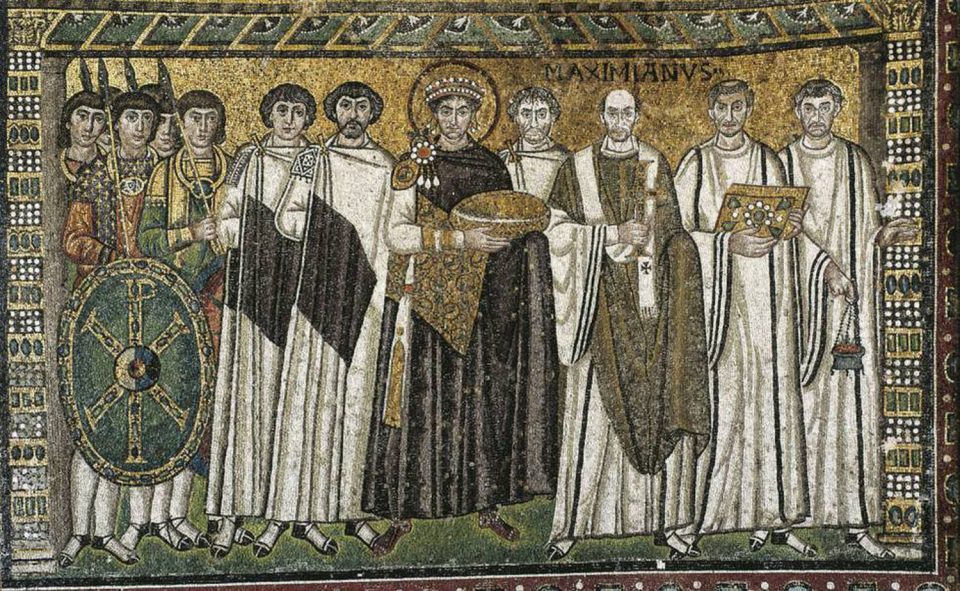A sixth-century mosaic of Byzantine ruler Justinian and his court in the church of San Vitale in Ravenna, Italy.Getty Images
New research from the University of Barcelona looks at the parallels between the current pandemic and the disease that swept across the Byzantine Empire 1,500 years ago
The pandemic originated in a foreign land and extended quickly through all the ports where infected passengers arrived – whether asymptomatic or not. There was no medical cure available to stop it, all residents were confined to their homes to avoid contagion, the economy ground to a halt, the army was deployed on the streets, exhausted physicians worked themselves to the bone, and there were thousands of daily victims whose bodies went without burial “for days on end, because diggers could not work fast enough…”
This is not an account of the coronavirus pandemic of 2020. It is the chronicle provided by the historian Procopius of Caesarea about the outbreak of bubonic plague that befell the known world between 541 and 544, under Byzantine Emperor Justinian I. The disease swept across a vast territory, from China to the port cities of Hispania, as the Romans called the Iberian Peninsula.
A new study called La Plaga de Justinià, Segons el Testimoni de Procopi, (or The Plague of Justinian According to the Testimony of Procopius), by Jordina Sales Carbonell, a researcher at Barcelona University, adds new relevance to this ancient tale written 1,500 years ago.
“As of April 1, 2020, certain similarities and parallels observed in human behavior with regard to a virus and its consequences seem so familiar and contemporary that, despite the tragedy we are all personally experiencing, it remains a source of wonderment how history repeats itself,” writes this archeologist and historian Sales Carbonell, who works at the university’s Institute of Medieval Culture Research.
In the year 541, under the Byzantine ruler Justinian, there was an outbreak of bubonic plague in the empire. “The alarm was sounded in Egypt, from where the infection expanded quickly and lethally.” Procopius reflected it in his book History of the Wars, where he recounted Justinian’s military campaigns in Italy, Northern Africa and Hispania, and how soldiers spread the disease throughout the ports where they stopped – fundamentally in Europe, North Africa, the Sasanian Empire (Persia) and from there as far as China.
As the legal advisor to Belisarius, Justinian’s chief military commander, Procopius tagged along on the latter’s campaigns and thus became a “privileged witness” to the effects of a pandemic that came to be known as the Plague of Justinian.
“An epidemic broke out that nearly wiped out the entire human race and which is impossible to find an explanation for with words, not even with thoughts, except to put it down to the will of God,” wrote Procopius. “This epidemic did not affect a limited portion of the Earth, nor a specific set of men, nor was it reduced to a specific season of the year […], but instead spread and attacked all human life, no matter how different the individuals might be, without regard for nature or age.” The disease reached “every far corner of the world, as though afraid that it might miss a spot.”
A year after first being detected, the plague reached the capital of the empire, Byzantium (modern-day Istanbul), ravaging it for four months. “There was complete confinement and isolation,” writes Sales Carbonell in her study. “It was absolutely mandatory for ill people. But there was also a sort of spontaneous and intuitively voluntary self-confinement, largely motivated by the circumstances.”
“It was not at all easy to see anybody in public spaces, at least in Byzantium; instead everyone who was healthy was at home, caring for the sick or crying over their dead,” wrote Procopius.
Meanwhile, the economy was taking a nosedive. “Activity ceased and craftsmen dropped all the work they had been doing.” Unlike today, however, authorities were unable to guarantee the supply of essential services. “It seemed very hard to obtain bread or any other kind of food, so that, in the case of some patients, the end of their life was no doubt premature due to the lack of essential items,” wrote Procopius in History of the Wars.
“Many died because they had nobody to care for them,” he added. The caregivers of the era “dropped from exhaustion because they were unable to rest and were constantly suffering. Because of it, everyone felt more sorry for them than for the sick.”
Patrols on the streets
In light of the desperate situation, the emperor sent out groups of palace guards to patrol the streets and the bodies of people who died alone were buried at the expense of the imperial coffers, wrote the historian. Even Justinian himself fell prey to the plague, but he overcame it and continued to reign for over a decade.
The mortality peaks rose from 5,000 to 10,000 victims a day and more, so that, “although at first everyone cared for their dead at home, chaos became inevitable and corpses were also thrown inside the graves of others, either by stealth or using violence.” In time, the bodies began to pile up inside the wall towers, and there were no funeral services for them.
When the pandemic finally ended, one positive thing came out of it.
“Those who had backed the various political factions dropped the mutual reproaches. Even those who had previously been given to low and evil acts abandoned all evil in their everyday lives, because imperious need made them learn about honesty,” wrote Procopius.
“This element of poetry offers a modicum of hope that maybe we will get through this and not trip again over the same stone,” says Sales Carbonell, sounding more hopeful than sure of herself.
The is originally published in EL PAIS

